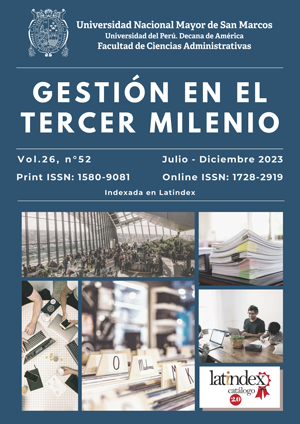Relationship between pandemic fatigue and work motivation in graduate students from a state university in Peru
DOI:
https://doi.org/10.15381/gtm.v26i52.27069Keywords:
Fatigue, stress, human resources, graduate school, universityAbstract
The aim of this study was to determine the relationship between pandemic fatigue and workplace motivation in graduate students from a state university in Peru in 2022. A correlational, non-experimental, simple and descriptive quantitative study was performed, based on a structured questionnaire administered to the demographic group from the study, with a sample of 30 students. Regarding reliability, Cronbach's alpha was 70.4% for the validity of the 21-item questionnaire used in the pilot prototype. The findings showed that 60.0% of survey respondents reported that they sometimes felt work-related stress in the workplace. 66.7% of survey respondents reported that they sometimes felt anxiety during working hours, while 66.7% reported that they sometimes felt some physical and emotional tension during working hours. Meanwhile, 46.7% reported that they had a harmonious relationship with their superior. In addition, 66.3% reported that they have good social relationships with their peers; lastly, 53.3% reported that they felt satisfaction in their current position. Regarding the correlation analysis for variable association, a value of -.586 was obtained, with p < .001, therefore confirming the general hypothesis. It is concluded that pandemic fatigue has a moderate correlation with employee motivation, considering the coefficient value of 0.586. However, there are strategies that can be implemented to mitigate its effects.
Downloads
Published
Issue
Section
License
Copyright (c) 2023 Elizabeth Juana Ruth Aldave Campos

This work is licensed under a Creative Commons Attribution 4.0 International License.
THE AUTHORS RETAIN THEIR RIGHTS:
(a) The authors retain their trademark and patent rights, and also over any process or procedure described in the article.
(b) The authors retain the right to share, copy, distribute, execute and publicly communicate the article published in Gestión en el Tercer Milenio journal (for example, place it in an institutional repository or publish it in a book), with acknowledgment of its initial publication in the Gestión en el Tercer Milenio.
(c) Authors retain the right to make a subsequent publication of their work, to use the article or any part of it (for example: a compilation of their work, lecture notes, thesis, or for a book), provided that they indicate the source. of publication (authors of the work, magazine, volume, number and date).













